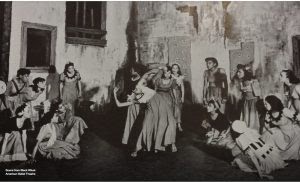American Ballet Theatre Negro Unit and Black Ritual

Agnes de Mille’s Black Ritual or Obeah was created for the 16 Black female dancers of the Negro Unit of Ballet Theatre. All of these dancers were trained in dance, despite later claims that they were “unschooled” and “untrained.” The dancers included Lawaune Kennard, Lavinia Williams, Anne Jones, Dorothy Williams, Elizabeth Thompson, Evelyn Pilcher, Edith Ross, Valerie Black, Leonore “Azelean” Cox, Edith Hurd, Mabel Hart, Maudelle Bass, Clementine Collinwood, Carole Ash, Bernice Willis, and Muriel Cook.
Agnes de Mille was recruited by co-founder of the American Ballet Theatre, Richard Pleasant, to choreograph for the company, but only under the condition that de Mille not perform in any of her ballets. Frustrated by the fact that she could not perform in her own ballet, de Mille turned Black Ritual, created specifically for the company’s Negro Unit, into “something slightly more sinister in her objectification of the dancers and the ominous plot of the ballet, creating a division that formed the ‘other’” (Beacham).

The work ultimately told the story of a group of “primitive” women planning to kill one of their group members, who would carry their sorrows to Hell. The ballet depicted the sacrificial character dancing herself into a frenzy in the midst of her executioners, who finally take her down before they rush back into the dark and mysterious forest.
The ballet’s subtitle, Obeah, refers to a type of Afro-Caribbean religious practice, however no additional cultural details were provided by the choreographer or company. The evening’s program, which did not name any of the Negro Unit’s dancers performing in the work, read:
“Every primitive religion contains the ritual of blood sacrifice, such as the killing of the god, or the sanctified victim in proxy for the god. This annual destruction and rebirth compasses the regeneration of Man and Earth…This ritual scene makes no claim to authenticity. Set vaguely somewhere in the West Indies, it attempts only to project the psychological atmosphere of a primitive community during the performance of austere and vital ceremonies” (Beacham).
First performed one week into Ballet Theatre’s inaugural season, on January 22, 1940, Black Ritual marked the first time Black dancers had appeared in a large-scale production from what was a typically all-white ballet company. The work pushed white audience members to contemplate and reevaluate the prevalent stereotypes and misconceptions surrounding Black dancers. In a letter to the World-Telegram of New York, publicists for the Ballet Theatre explained of Black Ritual: “This is a far cry from some of the traditional ballets being presented in the Ballet Theatre repertoire. But this was how the Ballet Theatre was meant to be—a combination of tradition and ultra-modernity” (Beacham). However, the ballet’s narrative destructively framed these Black characters as “primitive,” or the uncivilized cultural “other.”
Black Ritual received a variety of reviews. While Black critics described the work as a meaningful accomplishment, white critics seemed more inclined to interpret it as a novel anomaly within the ballet world. The following excerpt from The Chicago Defender, published on February 3, 1940, highlights the work as a success: “When the Ballet Theatre opened its doors for the first time at Rockefeller Center last Monday evening, little did it realize its occupants would behold one of the greatest performances in the history of the ballet—little did it realize that they would really know what it meant to be spell-bound—little did it realize the curtains of its theatre would rise and fall once, twice, ten or even more times, amid shouts of ‘bravo’ and deafening sounds of handclaps while a group of Race girls stood to receive the applause–but that is just what happened.”
After being performed only three times in 1940, Black Ritual has since been revived once, which was for the 75th anniversary of the American Ballet Theater in 2014. This revival production starred American ballet dancer Misty Copeland.
Sources:
Maher, Erin K. “Ballet, Race, and Agnes de Mille’s Black Ritual.” The Musical Quarterly, vol. 97, no. 3, Fall 2014, pp. 390-428.
Bethany Beacham, The Beginning: The Negro Unit of Ballet Theatre and Agnes de Mille’s Black Ritual, American Ballet Theatre
“Ballet Dance at Center Draws Unstinted Praise.” The Chicago Defender (National Edition) (1921-1967), Feb 03, 1940.

McClain Groff

